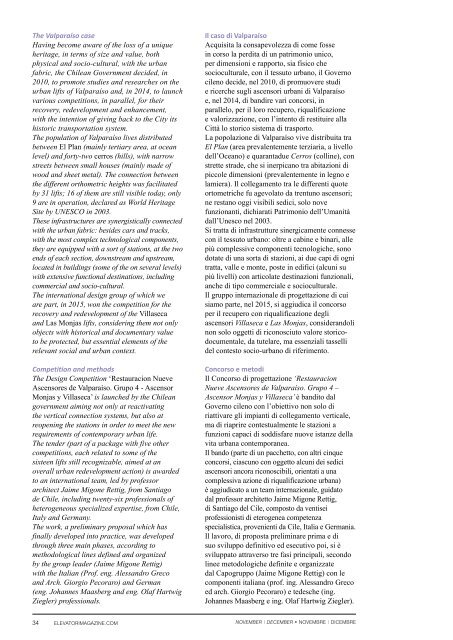Create successful ePaper yourself
Turn your PDF publications into a flip-book with our unique Google optimized e-Paper software.
The Valparaíso case<br />
Having become aware of the loss of a unique<br />
heritage, in terms of size and value, both<br />
physical and socio-cultural, with the urban<br />
fabric, the Chilean Government decided, in<br />
2010, to promote studies and researches on the<br />
urban lifts of Valparaíso and, in 2014, to launch<br />
various competitions, in parallel, for their<br />
recovery, redevelopment and enhancement,<br />
with the intention of giving back to the City its<br />
historic transportation system.<br />
The population of Valparaíso lives distributed<br />
between El Plan (mainly tertiary area, at ocean<br />
level) and forty-two cerros (hills), with narrow<br />
streets between small houses (mainly made of<br />
wood and sheet metal). The connection between<br />
the different orthometric heights was facilitated<br />
by 31 lifts; 16 of them are still visible today, only<br />
9 are in operation, declared as World Heritage<br />
Site by UNESCO in 2003.<br />
These infrastructures are synergistically connected<br />
with the urban fabric: besides cars and tracks,<br />
with the most complex technological components,<br />
they are equipped with a sort of stations, at the two<br />
ends of each section, downstream and upstream,<br />
located in buildings (some of the on several levels)<br />
with extensive functional destinations, including<br />
commercial and socio-cultural.<br />
The international design group of which we<br />
are part, in 2015, won the competition for the<br />
recovery and redevelopment of the Villaseca<br />
and Las Monjas lifts, considering them not only<br />
objects with historical and documentary value<br />
to be protected, but essential elements of the<br />
relevant social and urban context.<br />
Competition and methods<br />
The Design Competition ‘Restauracion Nueve<br />
Ascensores de Valparaíso. Grupo 4 - Ascensor<br />
Monjas y Villaseca’ is launched by the Chilean<br />
government aiming not only at reactivating<br />
the vertical connection systems, but also at<br />
reopening the stations in order to meet the new<br />
requirements of contemporary urban life.<br />
The tender (part of a package with five other<br />
competitions, each related to some of the<br />
sixteen lifts still recognizable, aimed at an<br />
overall urban redevelopment action) is awarded<br />
to an international team, led by professor<br />
architect Jaime Migone Rettig, from Santiago<br />
de Chile, including twenty-six professionals of<br />
heterogeneous specialized expertise, from Chile,<br />
Italy and Germany.<br />
The work, a preliminary proposal which has<br />
finally developed into practice, was developed<br />
through three main phases, according to<br />
methodological lines defined and organized<br />
by the group leader (Jaime Migone Rettig)<br />
with the Italian (Prof. eng. Alessandro Greco<br />
and Arch. Giorgio Pecoraro) and German<br />
(eng. Johannes Maasberg and eng. Olaf Hartwig<br />
Ziegler) professionals.<br />
Il caso di Valparaíso<br />
Acquisita la consapevolezza di come fosse<br />
in corso la perdita di un patrimonio unico,<br />
per dimensioni e rapporto, sia fisico che<br />
socioculturale, con il tessuto urbano, il Governo<br />
cileno decide, nel 2010, di promuovere studi<br />
e ricerche sugli ascensori urbani di Valparaíso<br />
e, nel 2014, di bandire vari concorsi, in<br />
parallelo, per il loro recupero, riqualificazione<br />
e valorizzazione, con l’intento di restituire alla<br />
Città lo storico sistema di trasporto.<br />
La popolazione di Valparaíso vive distribuita tra<br />
El Plan (area prevalentemente terziaria, a livello<br />
dell’Oceano) e quarantadue Cerros (colline), con<br />
strette strade, che si inerpicano tra abitazioni di<br />
piccole dimensioni (prevalentemente in legno e<br />
lamiera). Il collegamento tra le differenti quote<br />
ortometriche fu agevolato da trentuno ascensori;<br />
ne restano oggi visibili sedici, solo nove<br />
funzionanti, dichiarati Patrimonio dell’Umanità<br />
dall’Unesco nel 2003.<br />
Si tratta di infrastrutture sinergicamente connesse<br />
con il tessuto urbano: oltre a cabine e binari, alle<br />
più complessive componenti tecnologiche, sono<br />
dotate di una sorta di stazioni, ai due capi di ogni<br />
tratta, valle e monte, poste in edifici (alcuni su<br />
più livelli) con articolate destinazioni funzionali,<br />
anche di tipo commerciale e socioculturale.<br />
Il gruppo internazionale di progettazione di cui<br />
siamo parte, nel 2015, si aggiudica il concorso<br />
per il recupero con riqualificazione degli<br />
ascensori Villaseca e Las Monjas, considerandoli<br />
non solo oggetti di riconosciuto valore storicodocumentale,<br />
da tutelare, ma essenziali tasselli<br />
del contesto socio-urbano di riferimento.<br />
Concorso e metodi<br />
Il Concorso di progettazione ‘Restauracion<br />
Nueve Ascensores de Valparaíso. Grupo 4 –<br />
Ascensor Monjas y Villaseca’ è bandito dal<br />
Governo cileno con l’obiettivo non solo di<br />
riattivare gli impianti di collegamento verticale,<br />
ma di riaprire contestualmente le stazioni a<br />
funzioni capaci di soddisfare nuove istanze della<br />
vita urbana contemporanea.<br />
Il bando (parte di un pacchetto, con altri cinque<br />
concorsi, ciascuno con oggetto alcuni dei sedici<br />
ascensori ancora riconoscibili, orientati a una<br />
complessiva azione di riqualificazione urbana)<br />
è aggiudicato a un team internazionale, guidato<br />
dal professor architetto Jaime Migone Rettig,<br />
di Santiago del Cile, composto da ventisei<br />
professionisti di eterogenea competenza<br />
specialistica, provenienti da Cile, Italia e Germania.<br />
Il lavoro, di proposta preliminare prima e di<br />
suo sviluppo definitivo ed esecutivo poi, si è<br />
sviluppato attraverso tre fasi principali, secondo<br />
linee metodologiche definite e organizzate<br />
dal Capogruppo (Jaime Migone Rettig) con le<br />
componenti italiana (prof. ing. Alessandro Greco<br />
ed arch. Giorgio Pecoraro) e tedesche (ing.<br />
Johannes Maasberg e ing. Olaf Hartwig Ziegler).<br />
34 ELEVATORIMAGAZINE.COM NOVEMBER | DECEMBER • NOVEMBRE | DICEMBRE














